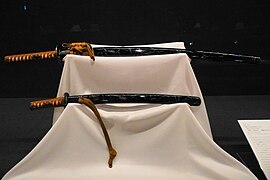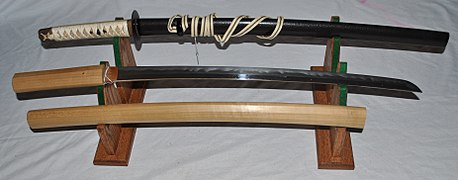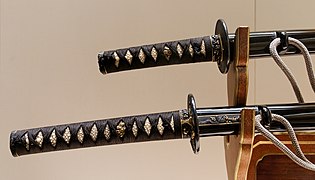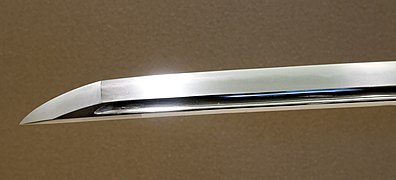Katana
| Katana (日本刀) | |
|---|---|
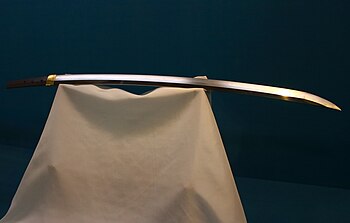 A katana modified from a tachi forged by Motoshige. Bizen Osafune school influenced by the Sōshū school. 14th century, Nanboku-chō period. Important Cultural Property. Tokyo National Museum | |
| Type | Sword |
| Place of origin | Japan |
| Service history | |
| Used by | Samurai, Onna-musha, Ninja, Kendo, Iaido practitioners |
| Production history | |
| Produced | Nanboku-chō period (1336-1392) which corresponds to the early Muromachi period (1336–1573)[1] to present |
| Specifications | |
| Mass | approx. 1.1–1.5 kg (2.4–3.3 lb) |
| Blade length | approx. 60–80 cm (24–31 in) |
| Blade type | Curved, single-edged |
| Hilt type | Two-handed swept, with circular or squared guard |
| Scabbard/sheath | Lacquered wood, some are covered with fish skin, decorated with brass and copper.[2][3] |
A katana (刀, かたな) is a Japanese sword characterized by a curved, single-edged blade with a circular or squared guard and long grip to accommodate two hands. Developed later than the tachi, it was used by samurai in feudal Japan and worn with the edge facing upward. Since the Muromachi period, many old tachi were cut from the root and shortened, and the blade at the root was crushed and converted into a katana.[4] The specific term for katana in Japan is uchigatana (打刀) and the term katana (刀) often refers to single-edged swords from around the world.[5]
Etymology and loanwords

The word katana first appears in Japanese in the Nihon Shoki of 720. The term is a compound of kata ("one side, one-sided") + na ("blade"),[6][7][8] in contrast to the double-sided tsurugi. See more at the Wiktionary entry.
The katana belongs to the nihontō family of swords, and is distinguished by a blade length (nagasa) of more than 2 shaku, approximately 60 cm (24 in).[9]
Katana can also be known as dai or
As Japanese does not have separate plural and singular forms, both katanas and katana are considered acceptable forms in English.[11]
Pronounced [katana], the kun'yomi (Japanese reading) of the kanji 刀, originally meaning single edged blade (of any length) in Chinese, the word has been adopted as a loanword by the Portuguese.[12] In Portuguese the designation (spelled catana) means "large knife" or machete.[12]
Description
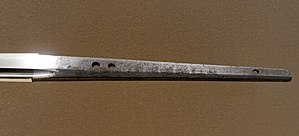
The katana is generally defined as the standard sized, moderately curved (as opposed to the older
With a few exceptions, katana and tachi can be distinguished from each other, if signed, by the location of the signature (mei) on the tang (nakago). In general, the mei should be carved into the side of the nakago which would face outward when the sword was worn. Since a tachi was worn with the cutting edge down, and the katana was worn with the cutting edge up, the mei would be in opposite locations on the tang.[14]
Western historians have said that katana were among the finest cutting weapons in world military history.
History
The production of swords in Japan is divided into specific time periods:[21]
- Jōkotō (ancient swords, until around 900)
- Kotō (old swords from around 900–1596)
- Shintō (new swords 1596–1780)
- Shinshintō (newer swords 1781–1876)
- Gendaitō (modern or contemporary swords 1876–present)
Kotō (Old swords)




Katana originates from sasuga (刺刀), a kind of
The first use of katana as a word to describe a long sword that was different from a tachi, occurs as early as the Kamakura period.[13] These references to "uchigatana" and "tsubagatana" seem to indicate a different style of sword, possibly a less costly sword for lower-ranking warriors. Starting around the year 1400, long swords signed with the katana-style mei were made. This was in response to samurai wearing their tachi in what is now called "katana style" (cutting edge up). Japanese swords are traditionally worn with the mei facing away from the wearer. When a tachi was worn in the style of a katana, with the cutting edge up, the tachi's signature would be facing the wrong way. The fact that swordsmiths started signing swords with a katana signature shows that some samurai of that time period had started wearing their swords in a different manner.[25][26]
By the 15th century, Japanese swords, including katana, had already gained international fame by being exported to China and Korea.[27] For example, Korea learned how to make Japanese swords by sending swordsmiths to Japan and inviting Japanese swordsmiths to Korea. According to the record of June 1, 1430 in the Veritable Records of the Joseon Dynasty, a Korean swordsmith who went to Japan and mastered the method of making Japanese swords presented a Japanese sword to the King of Korea and was rewarded for the excellent work which was no different from the swords made by the Japanese.[27][28]
Traditionally, yumi (bows) were the main weapon of war in Japan, and tachi and naginata were used only for close combat. The Ōnin War in the late 15th century in the Muromachi period expanded into a large-scale domestic war, in which employed farmers called ashigaru were mobilized in large numbers. They fought on foot using katana shorter than tachi. In the Sengoku period (period of warring states) in the late Muromachi period, the war became bigger and ashigaru fought in a close formation using yari (spears) lent to them. Furthermore, in the late 16th century, tanegashima (muskets) were introduced from Portugal, and Japanese swordsmiths mass-produced improved products, with ashigaru fighting with leased guns. On the battlefield in Japan, guns and spears became main weapons in addition to bows. Due to the changes in fighting styles in these wars, the tachi and naginata became obsolete among samurai, and the katana, which was easy to carry, became the mainstream. The dazzling looking tachi gradually became a symbol of the authority of high-ranking samurai.[22][20][19]
On the other hand, kenjutsu (swordsmanship) that makes use of the characteristics of katana was invented. The quicker draw of the sword was well suited to combat where victory depended heavily on short response times. (The practice and martial art for drawing the sword quickly and responding to a sudden attack was called battōjutsu, which is still kept alive through the teaching of iaido.) The katana further facilitated this by being worn thrust through a belt-like sash (obi) with the sharpened edge facing up. Ideally, samurai could draw the sword and strike the enemy in a single motion. Previously, the curved tachi had been worn with the edge of the blade facing down and suspended from a belt.[13][29]
From the 15th century, low-quality swords were mass-produced under the influence of the large-scale war. These swords, along with spears, were lent to recruited farmers called ashigaru and swords were exported. Such mass-produced swords are called kazuuchimono, and swordsmiths of the Bisen school and Mino school produced them by division of labor.[22][30] The export of katana and tachi reached its peak during this period, from the late 15th century to early 16th century when at least 200,000 swords were shipped to Ming dynasty China in official trade in an attempt to soak up the production of Japanese weapons and make it harder for pirates in the area to arm. In the Ming dynasty of China, Japanese swords and their tactics were studied to repel pirates, and wodao and miaodao were developed based on Japanese swords.[2][31][32]
From this period, the
From around the 16th century, many Japanese swords were exported to Thailand, where katana-style swords were made and prized for battle and art work, and some of them are in the collections of the Thai royal family.[34]

From the late Muromachi period (Sengoku period) to the early Edo period, samurai were sometimes equipped with a katana blade pointing downwards like a tachi. This style of sword is called handachi, "half tachi". In handachi, both styles were often mixed, for example, fastening to the obi was katana style, but metalworking of the scabbard was tachi style.[35]
In the Muromachi period, especially the Sengoku period, people such as farmers, townspeople, and monks could have a sword. However, in 1588 Toyotomi Hideyoshi banned farmers from owning weapons and conducted a sword hunt to forcibly remove swords from anyone identifying as a farmer.[24]
The length of the katana blade varied considerably during the course of its history. In the late 14th and early 15th centuries, katana blades tended to have lengths between 70 and 73 centimetres (28 and 29 in). During the early 16th century, the average length dropped about 10 centimetres (3.9 in), approaching closer to 60 centimetres (24 in). By the late 16th century, the average length had increased again by about 13 centimetres (5.1 in), returning to approximately 73 centimetres (29 in).[29]
Shintō (New swords)
Swords forged after 1596 in the Keichō period of the Azuchi–Momoyama period are classified as shintō (New swords). Japanese swords from shintō are different from kotō in forging method and steel (tamahagane). This is thought to be because Bizen school, which was the largest swordsmith group of Japanese swords, was destroyed by a great flood in 1590 and the mainstream shifted to Mino school, and because Toyotomi Hideyoshi virtually unified Japan, uniform steel began to be distributed throughout Japan. The kotō swords, especially the Bizen school swords made in the Kamakura period, had a midare-utsuri like a white mist between hamon and shinogi, but in the swords from shintō it has almost disappeared. In addition, the whole body of the blade became whitish and hard. Almost no one was able to reproduce midare-utsurii until Kunihira Kawachi reproduced it in 2014.[36][37]

As the Sengoku period (period of warring states) ended and the Azuchi-Momoyama period to the Edo period started, katana-forging also developed into a highly intricate and well-respected art form. Lacquered saya (scabbards), ornate engraved fittings, silk handles and elegant tsuba (handguards) were popular among samurai in the Edo period, and eventually (especially when Japan was in peace time), katana became more cosmetic and ceremonial items than practical weapons.[38] The Umetada school led by Umetada Myoju who was considered to be the founder of shinto led the improvement of the artistry of Japanese swords in this period. They were both swordsmiths and metalsmiths, and were famous for carving the blade, making metal accouterments such as tsuba (handguard), remodeling from tachi to katana (suriage), and inscriptions inlaid with gold.[39]
During this period, the Tokugawa shogunate required samurai to wear katana and shorter swords in pairs. These short swords were wakizashi and tantō, and wakizashi were mainly selected. This set of two is called a daishō. Only samurai could wear the daishō: it represented their social power and personal honour.[13][29][40] Samurai could wear decorative sword mountings in their daily lives, but the Tokugawa shogunate regulated the formal sword that samurai wore when visiting a castle by regulating it as a daisho made of a black scabbard, a hilt wrapped with white ray skin and black string.[41] Japanese swords made in this period are classified as shintō.[42]
Shinshintō (New swords)


In the late 18th century, swordsmith Suishinshi Masahide criticized that the present katana blades only emphasized decoration and had a problem with their toughness. He insisted that the bold and strong kotō blade from the Kamakura period to the Nanboku-chō period was the ideal Japanese sword, and started a movement to restore the production method and apply it to Katana. Katana made after this is classified as a shinshintō.[42] One of the most popular swordsmiths in Japan today is Minamoto Kiyomaro who was active in this shinshintō period. His popularity is due to his timeless exceptional skill, as he was nicknamed "Masamune in Yotsuya" after his disastrous life. His works were traded at high prices and exhibitions were held at museums all over Japan from 2013 to 2014.[43][44][45]
The idea that the blade of a sword in the Kamakura period is the best has been continued until now, and as of the 21st century, 80% of Japanese swords designated as National treasure in Japan were made in the Kamakura period, and 70% of them were tachi.[46][47]
The arrival of
Gendaitō (modern or contemporary swords)
Meiji – World War II
During the
Military action by Japan in China and Russia during the Meiji period helped revive interest in swords, but it was not until the

During the pre-
Post-World War II

Between 1945 and 1953, sword manufacture and sword-related
Outside Japan, some of the modern katanas being produced by western swordsmiths use modern steel alloys, such as
Mass-produced swords including iaitō and shinken in the shape of katana are available from many countries, though China dominates the market.[56] These types of swords are typically mass-produced and made with a wide variety of steels and methods.
According to the Parliamentary Association for the Preservation and Promotion of Japanese Swords, organized by Japanese Diet members, many katana distributed around the world as of the 21st century are fake Japanese swords made in China. The Sankei Shimbun analyzed that this is because the Japanese government allowed swordsmiths to make only 24 Japanese swords per person per year in order to maintain the quality of Japanese swords.[57][58]
Many swordsmiths after the Edo period have tried to reproduce the sword of the Kamakura period which is considered as the best sword in the history of Japanese swords, but they have failed. Then, in 2014, Kunihira Kawachi succeeded in reproducing it and won the Masamune Prize, the highest honor as a swordsmith. No one could win the Masamune Prize unless he made an extraordinary achievement, and in the section of tachi and katana, no one had won for 18 years before Kawauchi.[37]
Types

Katana are distinguished by their type of blade:
- Shinogi-Zukuri is the most common blade shape for Japanese katana that provides both speed and cutting power. It features a distinct yokote: a line or bevel that separates the finish of the main blade and the finish of the tip. Shinogi-zukuri was originally produced after the Heian period.
- Shobu-Zukuri is a variation of shinogi-zukuri without a yokote, the distinct angle between the long cutting edge and the point section. Instead, the edge curves smoothly and uninterrupted into the point.
- Kissaki-Moroha-Zukuri is a katana blade shape with a distinctive curved and double-edged blade. One edge of the blade is shaped in normal katana fashion while the tip is symmetrical and both edges of the blade are sharp.
In addition to these, there are various other types of blades with different shapes, such as Osoraku-zukuri, Unokubi-zukuri, and Kammuri-otoshi-zukuri.
Forging and construction


Typical features of Japanese swords represented by katana and tachi are a three-dimensional cross-sectional shape of an elongated pentagonal to hexagonal blade called shinogi-zukuri, a style in which the blade and the tang (nakago) are integrated and fixed to the hilt (tsuka) with a pin called mekugi, and a gentle curve. When a shinogi-zukuri sword is viewed from the side, there is a ridge line of the thickest part of the blade called shinogi between the cutting-edge side and the back side. This shinogi contributes to lightening and toughening of the blade and high cutting ability.[59]
Katana are traditionally made from a specialized Japanese steel called tamahagane,[60] which is created from a traditional smelting process that results in several, layered steels with different carbon concentrations.[61] This process helps remove impurities and even out the carbon content of the steel. The age of the steel plays a role in the ability to remove impurities, with older steel having a higher oxygen concentration, being more easily stretched and rid of impurities during hammering, resulting in a stronger blade.[62] The smith begins by folding and welding pieces of the steel several times to work out most of the differences in the steel. The resulting block of steel is then drawn out to form a billet.
At this stage, it is only slightly curved or may have no curve at all. The katana's gentle curvature is attained by a process of


This process also creates the line down the sides of the blade called the hamon, which is made distinct by polishing. Each hamon and each smith's style of hamon is distinct.[29] Hamon does not refer to the white area on the side of the blade. The white part is the part that is whitened by a polishing process called hadori to make it easier to see the hamon, and the actual hamon is a fuzzy line within the white part. The actual line of the hamon can be seen by holding the sword in your hand and looking at it while changing the angle of the light shining on the blade.[65][66]
After the blade is forged, it is then sent to be polished. The polishing takes between one and three weeks. The polisher uses a series of successively finer grains of polishing stones in a process called glazing, until the blade has a mirror finish. However, the blunt edge of the katana is often given a matte finish to emphasize the hamon.[29]
Japanese swords are generally made by a division of labor between six and eight craftsmen. Tosho (Toko, Katanakaji) is in charge of forging blades, togishi is in charge of polishing blades, kinkosi (chokinshi) is in charge of making metal fittings for sword fittings, shiroganeshi is in charge of making habaki (blade collar), sayashi is in charge of making scabbards, nurishi is in charge of applying lacquer to scabbards, tsukamakishi is in charge of making hilt, and tsubashi is in charge of making tsuba (hand guard). Tosho use apprentice swordsmiths as assistants. Prior to the Muromachi period, tosho and kacchushi (armorer) used surplus metal to make tsuba, but from the Muromachi period onwards, specialized craftsmen began to make tsuba. Nowadays, kinkoshi sometimes serves as shiroganeshi and tsubashi.[67][68]
Appreciation
Historically, katana have been regarded not only as weapons but also as works of art, especially for high-quality ones. For a long time, Japanese people have developed a unique appreciation method in which the blade is regarded as the core of their aesthetic evaluation rather than the sword mountings decorated with luxurious lacquer or metal works.[69][70]
It is said that there are three objects that are the most noteworthy when appreciating a blade. The first is the overall shape referred to as sugata which is the curvature, length, width, tip, and shape of tang of the sword. The second is a fine pattern on the surface of the blade, which is referred to as hada or jigane. By repeatedly folding and forging the blade, fine patterns such as fingerprints, tree rings and bark are formed on its surface. The third is hamon. Hamon is a fuzzy line in the white pattern of the cutting edge produced by quenching and tempering. The object of appreciation is the shape of hamon and the crystal particles formed at the boundary of hamon. Depending on the size of the particles, they can be divided into two types, a nie and a nioi, which makes them look like stars or mist. The pattern, nie and nioi of the hamon are generally difficult to see, and the viewer usually holds the sword in his hand, changing the angle of the light as it hits the blade. In addition to these three objects, a swordsmith signature and a file pattern engraved on tang, and a carving inscribed on the blade, which is referred to as horimono, are also the objects of appreciation.[65][66][69][70]
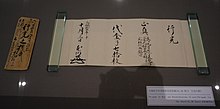
The Hon'ami clan, which was an authority of appraisal of Japanese swords, rated Japanese swords from these artistic points of view. In addition, experts of modern Japanese swords judge when and by which swordsmith school the sword was made from these artistic points of view.[69][70]
Generally, the blade and the sword mounting of Japanese swords are displayed separately in museums, and this tendency is remarkable in Japan. For example, the Nagoya Japanese Sword Museum "Nagoya Touken World", one of Japan's largest sword museums, posts separate videos of the blade and the sword mounting on its official website and YouTube.[71][72]
Rating of Japanese swords and swordsmiths
In Japan, Japanese swords are rated by authorities of each period, and some of the authority of the rating is still valid today.
In 1719, Tokugawa Yoshimune, the 8th shogun of the Tokugawa shogunate, ordered Hon'ami Kōchū, who was an authority of sword appraisal, to record swords possessed by daimyo all over Japan in books. In the completed "Kyōhō Meibutsu Chō" (享保名物帳) 249 precious swords were described, and additional 25 swords were described later. The list also includes 81 swords that had been destroyed in previous fires. The precious swords described in this book were called "Meibutsu" (名物) and the criteria for selection were artistic elements, origins and legends. The list of "Meibutsu" includes 59 swords made by Masamune, 34 by Awataguchi Yoshimitsu and 22 by Go Yoshihiro, and these three swordsmiths were considered special. Daimyo hid some swords for fear that they would be confiscated by the Tokugawa Shogunate, so even some precious swords were not listed in the book. For example, Daihannya Nagamitsu and Yamatorige, which are now designated as National Treasures, were not listed.[46]

Yamada Asaemon V, who was the official sword cutting ability examiner and executioner of the Tokugawa shogunate, published a book "Kaiho Kenjaku" (懐宝剣尺) in 1797 in which he ranked the cutting ability of swords. The book lists 228 swordsmiths, whose forged swords are called "Wazamono" (業物) and the highest "Saijo Ō Wazamono" (最上大業物) has 12 selected. In the reprinting in 1805, one swordsmith was added to the highest grade, and in the major revised edition in 1830 "Kokon Kajibiko" (古今鍛冶備考), two swordsmiths were added to the highest grade, and in the end, 15 swordsmiths were ranked as the highest grade. The katana forged by Nagasone Kotetsu, one of the top-rated swordsmith, became very popular at the time when the book was published, and many counterfeits were made. In these books, the three swordsmiths treated specially in "Kyōhō Meibutsu Chō" and Muramasa, who was famous at that time for forging swords with high cutting ability, were not mentioned. The reasons for this are considered to be that Yamada was afraid of challenging the authority of the shogun, that he could not use the precious sword possessed by the daimyo in the examination, and that he was considerate of the legend of Muramasa's curse.[46][74]

At present, by the Law for the Protection of Cultural Properties, important swords of high historical value are designated as Important Cultural Properties (Jūyō Bunkazai, 重要文化財), and special swords among them are designated as National Treasures (Kokuhō, 国宝). The swords designated as cultural properties based on the law of 1930, which was already abolished, have the rank next to Important Cultural Properties as Important Art Object (Jūyō Bijutsuhin, 重要美術品). In addition, the Society for Preservation of Japanese Art Swords, a public interest incorporated foundation, rates high-value swords in four grades, and the highest grade Special Important Sword (Tokubetsu Juyo Token, 特別重要刀剣) is considered to be equivalent to the value of Important Art Object. Although swords owned by the Japanese imperial family are not designated as National Treasures or Important Cultural Properties because they are outside the jurisdiction of the Law for the Protection of Cultural Properties, there are many swords of the National Treasure class, and they are called "Gyobutsu" (御物).[46][75]
Currently, there are several authoritative rating systems for swordsmiths. According to the rating approved by the Japanese government, from 1890 to 1947, two swordsmiths who were appointed as Imperial Household Artist and after 1955, six swordsmiths who were designated as Living National Treasure are regarded as the best swordsmiths. According to the rating approved by The Society for Preservation of Japanese Art Swords, a public interest incorporated foundation, 39 swordsmiths who were designated as Mukansa (無鑑査) since 1958 are considered to be the highest ranking swordsmiths. The best sword forged by Japanese swordsmiths is awarded the most honorable Masamune prize by The Society for Preservation of Japanese Art Swords. Since 1961, eight swordsmiths have received the Masamune Prize, and among them, three swordsmiths, Masamine Sumitani, Akitsugu Amata and Toshihira Osumi, have received the prize three times each and Sadakazu Gassan II has received the prize two times. These four people were designated both Living National Treasures and Mukansa.[76]
Usage in martial arts
Katana were used by samurai both in the battlefield and for practicing several martial arts, and modern martial artists still use a variety of katana. Martial arts in which training with katana is used include
However, for safety reasons, katana used for martial arts are usually blunt edged
Storage and maintenance
If mishandled in its storage or maintenance, the katana may become irreparably damaged. The blade should be stored horizontally in its sheath, curve down and edge facing upward to maintain the edge. It is extremely important that the blade remain well-oiled, powdered and polished, as the natural moisture residue from the hands of the user will rapidly cause the blade to rust if not cleaned off. The traditional oil used is
World records
Multiple sword world records were made with a katana and verified by Guinness World Records. Iaido master Isao Machii set the record for "Most martial arts katana cuts to one mat (suegiri)",[81] "Fastest 1,000 martial arts sword cuts",[82] "Most sword cuts to straw mats in three minutes",[83] and "Fastest tennis ball (708km/h) cut by sword".[84] There are various records for Tameshigiri. For example, the Greek Agisilaos Vesexidis set the record for most martial arts sword cuts in one minute (73) on 25 June 2016.[85]
Ownership and trade restrictions
Republic of Ireland
Under the Firearms and Offensive Weapons Act 1990 (Offensive Weapons) (Amendment) Order 2009, katanas made post-1953 are illegal unless made by hand according to traditional methods.[86]
United Kingdom
As of April 2008, the
Gallery
-
A katana forged by Hizen Tadayoshi I. (Saijo Ō Wazamono) Azuchi-Momoyama period. (top) Katana mounting, Late Edo period. (bottom)
-
Katana mounting for Musashi Masamuneme, Edo period, The Japanese Sword Museum
-
A hirumaki (leech patterned) katana mounting coated with vermilion lacquer and wrapped in a thin silver plate, Edo period, The Japanese Sword Museum
-
Katana (Daishō) mountings with ice crack pattern design. Edo period, Designated as Important Mounting, The Japanese Sword Museum
-
Daishō style sword mounting, gold banding on red-lacquered ground. 16th century, Azuchi–Momoyama period. Important Cultural Property. Tokyo National Museum. These swords were owned by Toyotomi Hideyoshi.
-
Katana mounting with a polished black lacquer sheath, Edo period. Museum of Fine Arts, Boston.
-
Black lacquered hanamaruradendaishō koshirae. Meiji period.
-
Mounting for a katana forged by Motoshige. late 16th or early 17th century, Azuchi–Momoyama or Edo period. Important Cultural Property. Tokyo National Museum.
-
Antique Japanese katana withshirasaya, attributed to Sukenao, 1600s
-
Japanese katana showing a horimono (blade carving), Metropolitan Museum of Art
-
Hilt of katana. Early Edo period.
-
The inscription (mei) on the tang (nakago) of a katana forged by Hizen tadayoshi I, Azuchi-Momoyama period. (top) Hilt of katana. Late Edo period. (bottom)
-
Koshirae(mountings) of an Edo period daishō, rayskin wrapped with silk
-
Kissaki (point) of an Edo period katana
See also
- Longsword
- Kenjutsu
- Iaidō
- Japanese sword mountings
- Japanese sword
- Daishō
- Ōdachi
- Tachi
- Wakizashi
- Tenka-Goken ("Five Swords under Heaven") – five individual swords traditionally viewed as the best Japanese swords
- Backsword
- Broadsword
- Japanese swords in fiction
- Korean sword
- Hengdang
- Dha (sword)
- Wodao
References
- ^ ISBN 978-4651200408
- ^ ISBN 978-4062920933
- ^ "日本の技術の精巧さは…". Mainichi Shimbun. 27 March 2016. Archived from the original on 28 August 2016.
- ^ a b 日本刀鑑賞のポイント「日本刀の姿」 Nagoya Touken Museum Touken World.
- ^ 日本刀と刀の違い Nagoya Japanese Sword Museum Touken World
- ISBN 4-385-13905-9
- ^ "How Long Is a Katana?". Medieval Swords World. 3 August 2019. Retrieved 9 September 2019.
- ISBN 978-0-8048-2016-5.
- ISBN 9780262511230.
- ^ ISBN 978-81-206-0413-1.
- ^ ISBN 978-0-87011-562-2.
- ISBN 978-4-7700-2854-9.
- ISBN 9780756622107.
- ISBN 1855323451
- ^ ISBN 978-4651200408
- ^ a b 歴史人 September 2020. pp.40–43. ASIN B08DGRWN98
- ^ a b c Arms for battle – spears, swords, bows. Nagoya Japanese Sword Museum Touken World.
- ^ a b History of Japanese swords "Muromachi period - Azuchi-Momoyama period". Nagoya Japanese Sword Museum Touken World.
- ^ Transition of kotō, shintō, shinshintō, and gendaitō. Nagoya Japanese Sword Museum Touken World
- ^ a b c 歴史人 September 2020, p. 40. ASIN B08DGRWN98
- ^ List of terms related to Japanese swords "Sasuga". Nagoya Japanese Sword Museum Touken World.
- ^ a b Differences in Japanese swords according to status. Nagoya Japanese Sword Museum Touken World.
- ]
- ISBN 978-4-7700-2071-0.
- ^ a b Takeo Tanaka (1982) 対外関係と文化交流. p.348. Shibunkaku. ASIN B000J7JC30
- ^ Junko Oishi. "Analyzing the words of Wae-geom and Wae-geom-sa in Classical Korean literatures". p. 72. Archived from the original on 9 December 2022. Retrieved 9 December 2022.
- ^ ISBN 978-0-87011-798-5.
- ^ 歴史人 September 2020. pp. 70–71. ASIN B08DGRWN98
- ISBN 9784883172115
- ISBN 9784056063448
- ^ 相州伝の名工「正宗」. Nagoya Japanese Sword Museum Touken World.
- ^ Ayumi Harada (24 October 2016). "Reception and transformation of foreign cultures in Thailand; focusing on the foreign trade items of the 13th to 18th centuries" (PDF) (in Japanese). Japan Society for the Promotion of Science. Archived from the original (PDF) on 25 October 2021. Retrieved 11 December 2022.
- ^ weblio. Handachi-Goshirae.
- ^ History of Japanese sword. Nagoya Japanese Sword Museum Touken World.
- ^ a b 日本刀鑑賞のポイント「日本刀の映りとは」. Nagoya Japanese Sword Museum Touken World.
- ISBN 978-4907211110
- ^ 特別展「埋忠〈UMETADA〉桃山刀剣界の雄」. Internet Museum.
- ISBN 978-0-8048-1684-7.
- ISBN 978-4651200408
- ^ a b c 歴史人 September 2020, pp. 42–43. ASIN B08DGRWN98
- ^ 幕末に活躍した日本刀の名工「清麿」展=ダイナミックな切っ先、躍動感あふれる刃文. Jiji Press
- ^ 清麿展 -幕末の志士を魅了した名工- Internet Museum.
- ^ 源清麿 四谷正宗の異名を持つ新々刀随一の名工. Kōgetudō.
- ^ a b c d 日本刀の格付けと歴史. Touken World
- ^ 鎌倉期の古名刀をついに再現 論説委員・長辻象平. Sankei Shimbun. 2 July 2017.
- ^ ISBN 978-4-7700-2071-0.
- ^ Pinnacle of Elegance -Sword fittings of the Mitsumura Collection-. Nezu Museum.
- ^ The World of Edo Dandyism From Swords to Inro. Internet Museum
- ^ Pinnacle of Elegance -Sword fittings of the Mitsumura Collection-. Internet Museum.
- ^ ISBN 978-1-59228-720-8.
- ISBN 978-1-4629-0706-9.
- ISBN 978-4-7700-1962-2.
- ISBN 978-1-59228-720-8.
- ISBN 978-1-4402-1638-1.
- ^ Sankei Shimbun, June 22, 2018, p. 1.
- ^ Sankei Shimbun, June 22, 2018, p. 2.
- ^ 歴史人 September 2020, pp. 36, 47, 50. ASIN B08DGRWN98
- ISBN 978-4-526-06012-0.
- ^ "Secrets of the Samurai Sword". Pbs.org. Retrieved 2013-08-08.
- ^ "Step 1: Types of Katana Swords". Katana Sword Reviews. 3 September 2015. Retrieved 25 April 2016.
- ISBN 978-0-307-43074-8.
- ISBN 978-1-84642-869-2.
- ^ a b 備前長船刀剣博物館に関しての対談2 (in Japanese). Bizen Osafune touken Museum/Honshu-Shikoku Bridge Expressway Company. Archived from the original on 22 January 2022. Retrieved 26 February 2024.
- ^ a b いろんな刃文を観てみる (in Japanese). The Nagoya Japanese Sword Museum "Nagoya Touken World". Archived from the original on 30 April 2021. Retrieved 26 February 2024.
- ^ 刀装具の名工 Nagoya Japanese Sword Museum Nagoya Touken World
- ^ Bizen Osafune Japanese Sword. Setouchi City, Okayama Prefecture.
- ^ a b c How to appreciate a Japanese sword. Tozando.
- ^ ISBN 978-4651200408
- ^ Touken World YouTube videos about Japanese swords
- ^ Touken World YouTube videos on koshirae (sword mountings)
- ^ Katana Signed Nagasone Okisato Nyudo Kotetsu. Tokyo Fuji Art Museum.
- doi:10.11501/1265855
- ^ <審査規程第17条第1項に基づく審査基準>. Nihon Bijutsu Token Hozon Kyokai.
- ^ 日本刀の刀匠・刀工「無鑑査刀匠」. Nagoya Japanese Sword Museum Touken World.
- ISSN 0277-3066.
- ISBN 978-0-8126-9723-0.
- ISBN 978-1-59884-243-2.
- ISBN 978-0834802360.
- ^ Most martial arts sword cuts to one mat (Suegiri) Guinness world records.com
- ^ Fastest 1,000 martial arts sword cuts[permanent dead link] Guinness world records.com
- ^ Most sword cuts to straw mats in three minutes Guinness world records.com
- ^ Fastest tennis ball (820km/h) cut by sword Guinness world records.jp (in Japanese)
- ^ "Most martial arts sword cuts in one minute (rice straw)". Guinness World Records. 25 June 2016. Archived from the original on 29 May 2019.
- ^ "S.I. No. 338/2009 — Firearms and offensive Weapons Act 1990 (offensive Weapons) (Amendment) Order 2009". Irish Statute Book, Government of Ireland. 28 August 2009.
- ^ The Criminal Justice Act 1988 (Offensive Weapons)(Amendment) Order 2008. Opsi.gov.uk (19 November 2010). Retrieved 2013-08-08.
- ^ "Ban on imitation Samurai swords". BBC News. 12 December 2007. Retrieved 29 December 2011.
Calls for a ban came after a number of high-profile incidents in which cheap Samurai-style swords had been used as a weapon. The Home Office estimates there have been some 80 attacks in recent years involving Samurai-style blades, leading to at least five deaths.
- ^ EXPLANATORY MEMORANDUM TO THE CRIMINAL JUSTICE ACT 1988 (OFFENSIVE WEAPONS) (AMENDMENT No. 2): ORDER 2008. opsi.gov.uk. Retrieved 2013-08-08.
Further reading
- Perrin, Noel (1980). Giving Up the Gun: Japan's Reversion to the Sword, 1543–1879. Boston: David R. Godine. p. 140. ISBN 978-0-87773-184-9.
- Robinson, H. Russell (1969). Japanese Arms and Armor. New York: Crown Publishers Inc.
- Satō, Kanzan (1983). The Japanese Sword. Kodansha International. ISBN 9780870115622.
- Takeuchi (aka T), S. Alexander. "Dr. T's 'Nihonto Random Thoughts' Page". Florence, AL: Department of Sociology, University of North Alabama. Archived from the original on 8 January 2010.
- Yumoto, John M. (1958). The Samurai Sword: A Handbook. Boston: Tuttle Publishing. p. 204. ISBN 978-0-8048-0509-4.




